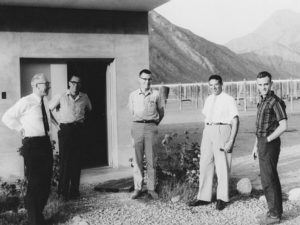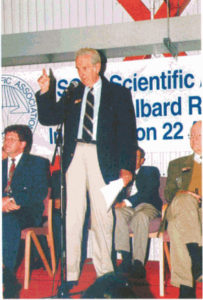60th anniversary
The 21st of October 1958 Ken Bowels measured the first incoherently scattered signal. Science then incoherent scatter radars have been constructed all over the world.
The start
In 1958 William Gordon (Gordon, 1958) at Cornell University in the United States proposed that individual ionospheric electrons might react to an incoming radar signal by oscillating at the same frequency, thus producing an (incoherent) electromagnetic signal measurable on the ground.
The discovery

Ken Bowles (middle) in Jicamarca, Peru.
The idea was experimentally confirmed the 21st of October in the same year by Kenneth Bowles (a recent Ph.D. graduate of Cornell) at the University of Illinois (Bowles, 1958). Bowles found that each ion in the upper ionosphere is surrounded by a cloud of electrons and scattering was essentially from the clouds. Soon it was stated that the incoherent scatter method allows measurement of ionospheric electron density, ion temperature and electron temperatures, ion composition and plasma velocity. A new powerful tool for studying the Earth’s ionosphere was invented.
Photo: Jicamarca Radio Observatory
The reveal

William Gordon giving the inauguration speech on the day of the inauguration of the EISCAT Svalbard Radar, 22 August 1996.
By a happy coin- cidence, 21 October was also the day that Gordon gave his first formal talk on the Incoherent Scatter Radar (ISR) concept at an International Union of Radio Science (URSI) conference at Pennsylvania State University. After calling Bowles for an update on his experiment, Gordon presented his research and added the dramatic and newsworthy note to the end of his talk on the success of the first ISR experiment!
The outcome
ISR has remained a useful technique for ionospheric studies, because a complete, accurate, and elegant theory describes the spectrum of the scattered signal, and because inexpensive and easily implemented digital signal processing makes the use of new radar techniques practical and allows new and better data analysis methods.
The future
Ten years ago we wrote in our Annual Report of 2008: “An amazing amount has happened in the field since then, many wonderful facilities have been constructed and operated in many countries, and many brilliant minds have contributed to the development of the theory, techniques, and hardware. Nevertheless, we are today arguably enjoying the most exciting period since those first echoes were received sixty years ago with the tremendous momentum now behind the EISCAT_3D initiative.”
Now 60 year after the first incoherent scatter radar measurement, EISCAT is starting to build a new generation incoherent scatter radar, EISCAT3D.
List of references
https://www.hist-geo-space-sci.net/2/113/2011/hgss-2-113-2011.pdf
https://www.sciencedirect.com/topics/earth-and-planetary-sciences/incoherent-scatter-radar
https://agupubs.onlinelibrary.wiley.com/doi/pdf/10.1029/2009EO310005
Last downloaded 2018-10-04




